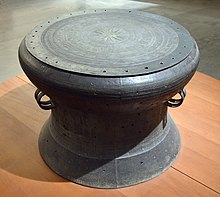
A Đông Sơn drum (Vietnamese: Trống đồng Đông Sơn, lit. 'Bronze drum of Đông Sơn'; also called Heger Type I drum)[1] is a type of ancient bronze drum created by the Đông Sơn culture that existed in the Red River Delta. The drums were produced from about 600 BCE or earlier until the third century CE; they are one of the culture's most astounding examples of ancient metalworking. The drums, cast in bronze using the lost-wax casting method are up to a meter in height and weigh up to 100 kilograms (220 lb). Đông Sơn drums were apparently both musical instruments and objects of worship.
They are decorated with geometric patterns, scenes of daily life, agriculture, war, animals and birds, and boats. The latter alludes to the importance of trade to the culture in which they were made, and the drums themselves became objects of trade and heirlooms. One of the recurring pattern is the Lạc bird found in the second outer ring and also in the symbolism of Mo (religion). More than 200 have been found, across an area from eastern Indonesia to Vietnam and parts of Southern China.[2]
The display on the surface of the Đông Sơn drums are often depicted across many cultural institutes of Vietnam, one being displayed in Vietnam parliamentary office during some of Vietnam's ASEAN summits.[3]
- ^ Himanshu Prabha Ray (14 Aug 2003). The Archaeology of Seafaring in Ancient South Asia. Cambridge University Press. p. 121. ISBN 9780521011099.
- ^ Heidhues, Mary Somers (2000). Southeast Asia: A Concise History. London: Thames and Hudson. pp. 19–20.
- ^ VietnamPlus (2021-10-27). "Thủ tướng dự Hội nghị cấp cao ASEAN-Australia thường niên lần thứ nhất | Chính trị | Vietnam+ (VietnamPlus)". VietnamPlus (in Vietnamese). Retrieved 2021-10-27.